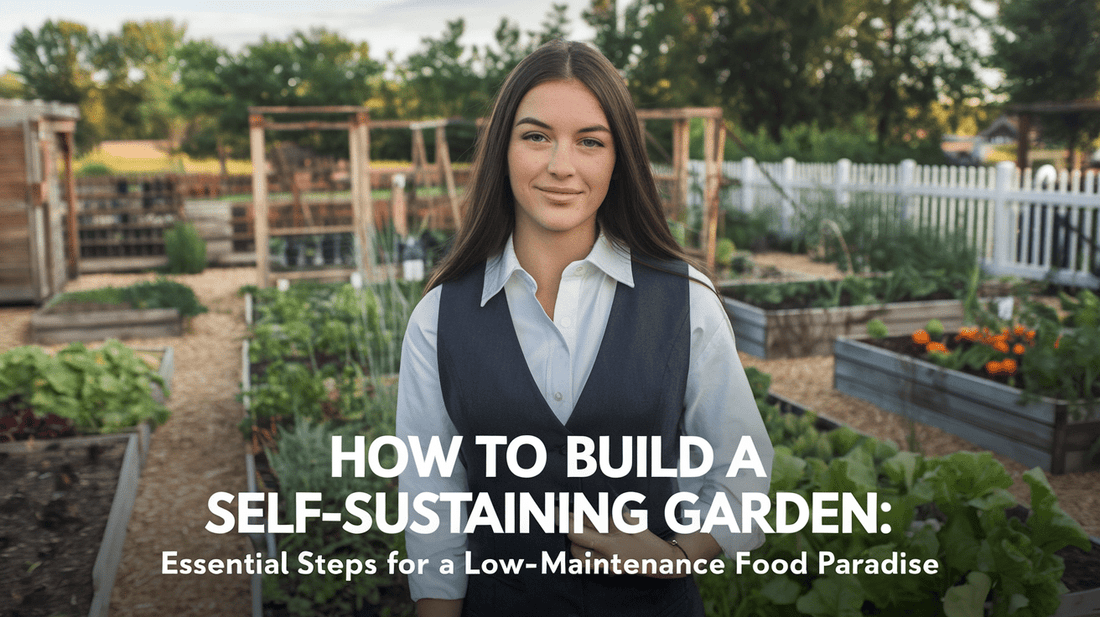
How to Build a Self-Sustaining Garden: Essential Steps for a Low-Maintenance Food Paradise
Share
February 15, 2025
A self-sustaining garden creates a mini ecosystem that needs minimal outside help to thrive. You can build one by focusing on natural growing methods, choosing the right plants, and creating healthy soil that maintains itself through composting and natural fertilizers. The goal is to grow food while working with nature instead of against it.
Creating a self-sustaining garden starts with picking a sunny spot and a few favorite crops. Your garden will get stronger each year as beneficial insects move in and the soil improves. Natural pest control happens when you build a balanced garden ecosystem where healthy plants resist disease and helpful bugs eat the harmful ones.
Starting small lets you learn what works in your space without getting overwhelmed. Focus on growing foods your family enjoys eating, and add companion plants that support each other's growth. This creates a garden that practically takes care of itself once established.
Key Takeaways
- Start with rich soil and natural growing methods to create a garden that maintains itself
- Choose plants that work together and match your local growing conditions
- Use water-smart techniques and composting to reduce the need for outside resources
Designing Your Garden Layout
A carefully planned garden layout maximizes growing space and creates ideal conditions for plants to thrive. Smart design choices reduce maintenance work while boosting garden productivity.
Understanding Sunlight and Shade
Start by mapping the sun patterns across your garden space throughout the day. Note which areas get full sun (6+ hours), partial sun (4-6 hours), and full shade.
Place tall plants like corn and sunflowers on the north side to prevent them from shading shorter plants.
Create shade-loving plant zones under trees or along north-facing walls. These spots work well for lettuce, spinach, and herbs.
Sun exposure tips:
- Track sunlight for a full day before finalizing placement
- Consider seasonal sun angle changes
- Leave space between rows for adequate light penetration
Soil Health and Composition
Test your soil pH and nutrient levels before planting. Most vegetables thrive in slightly acidic soil with pH 6.0-7.0.
Add organic matter like compost and aged manure to improve soil structure. Good soil helps retain moisture and provides essential nutrients.
Create healthy garden beds by layering:
- 2 inches of compost
- 4 inches of topsoil
- 2 inches of mulch
Rotate crops annually to prevent soil depletion and reduce pest problems.
Water Management Systems
Install drip irrigation or soaker hoses to deliver water directly to plant roots. This reduces water waste and prevents leaf diseases.
Collect rainwater in barrels placed under downspouts. Connect these to your irrigation system for free, natural watering.
Create slight slopes in garden beds to direct water flow. Add water-retaining features:
- Swales along contours
- Rain gardens in low spots
- Mulch layers to reduce evaporation
Integrating Plant Varieties
Choose self-sufficient plants that work together. Plant companions that benefit each other through nutrient sharing or pest control.
Mix these plant types throughout your garden:
- Deep-rooted crops (carrots, parsnips)
- Shallow-rooted plants (lettuce, herbs)
- Nitrogen fixers (peas, beans)
- Pest-repelling flowers (marigolds, nasturtiums)
Group plants with similar water and nutrient needs together. This makes maintenance easier and ensures each plant gets proper care.
Space plants according to mature size to prevent overcrowding. Leave room for air circulation to reduce disease problems.
Choosing the Right Plants
Plant selection is the foundation of a self-sustaining garden. The right mix of plants creates a balanced ecosystem that requires minimal maintenance while providing food and supporting local wildlife.
Vegetables and Fruits
Start with easy-to-grow vegetables that match your climate and space. Tomatoes, peppers, and leafy greens are excellent starter crops.
Choose varieties that suit your family's needs and focus on high-yield plants that store well, like potatoes, squash, and root vegetables.
Plant fruit trees and berry bushes along borders. These permanent fixtures produce food year after year with minimal care.
Consider these reliable producers:
- Tree fruits: Apples, pears, plums
- Bush fruits: Blueberries, raspberries, blackberries
- Vining fruits: Grapes, kiwis
Herbs and Medicinal Plants
Herbs serve multiple purposes in your garden. They attract pollinators, repel pests, and provide fresh flavors for cooking.
Essential herbs for your garden:
- Culinary: Basil, thyme, oregano, rosemary
- Medicinal: Chamomile, echinacea, mint, lavender
- Pest-repelling: Marigolds, nasturtiums, calendula
Plant herbs near vegetables they complement. Basil grows well with tomatoes, while rosemary helps protect cabbage family plants.
Perennials and Annuals
Perennials form the backbone of a sustainable garden. These plants return year after year, improving soil structure and reducing workload.
Key perennials to include:
- Asparagus
- Rhubarb
- Jerusalem artichokes
- Globe artichokes
Mix in fast-growing annuals like beans, peas, and corn to maximize seasonal production. These plants fix nitrogen in the soil and provide quick harvests.
Native Species
Native plants thrive with minimal care since they're adapted to local conditions. They support local wildlife and create natural pest control.
Choose native flowering plants that bloom at different times throughout the season. This ensures constant food for pollinators.
Popular native options include:
- Butterfly weed
- Purple coneflower
- Black-eyed susan
- Joe-pye weed
Plant native ground covers to suppress weeds and protect soil moisture. They create natural mulch and reduce maintenance needs.
Building Healthy Soil
Healthy soil forms the foundation of any self-sustaining garden. Rich, living soil provides essential nutrients, retains moisture, and supports beneficial organisms that help your plants thrive.
Composting Techniques
Start a compost pile with three basic ingredients: greens, browns, and water. Mix kitchen scraps like vegetable peelings and coffee grounds with dry leaves and paper.
Keep your pile as moist as a wrung-out sponge. Turn it every few weeks to add oxygen.
The ideal compost ratio is:
- 2 parts brown materials (leaves, straw, paper)
- 1 part green materials (food scraps, grass clippings)
- Small amounts of water as needed
Creating good compost takes 3-6 months. Your finished product should be dark, crumbly, and smell like fresh earth.
Organic Matter and Mulches
Add organic materials like leaves, grass clippings, and straw around your plants. This natural mulch keeps moisture in and weeds out.
Layer mulch 2-4 inches deep, keeping it away from plant stems. Replace it as it breaks down.
Best mulch materials:
- Fallen leaves
- Grass clippings
- Straw or hay
- Wood chips
- Pine needles
Natural Fertilizers and Amendments
Mix organic amendments into your soil to add specific nutrients. Different materials provide different benefits.
Key amendments and their benefits:
- Bone meal: phosphorus and calcium
- Blood meal: nitrogen
- Kelp: potassium and trace minerals
- Crushed eggshells: calcium
- Wood ash: potassium and pH adjustment
Test your soil pH yearly. Most plants prefer a pH between 6.0 and 7.0. Add lime to raise pH or sulfur to lower it.
Irrigation and Water Conservation
Smart water management keeps your garden thriving while reducing waste and environmental impact. Using efficient irrigation methods and collecting rainwater cuts water bills and supports plant health.
Drip Irrigation Installation
A drip irrigation system delivers water directly to plant roots through small tubes with holes or emitters. This targeted approach uses up to 50% less water than traditional sprinklers.
Start by connecting the main water line to a timer and pressure regulator. Run 1/2-inch tubing along your garden rows as the main lines.
Attach 1/4-inch feeder lines with emitters to reach individual plants. Place emitters 12-18 inches apart for small plants and 24 inches for larger ones.
Set your timer to water early morning or evening to minimize evaporation. Check tubes monthly for clogs or damage.
Rain Barrels and Storage
Install rain barrels under your roof downspouts to capture free water. A single 55-gallon barrel can fill up during one moderate rainfall.
Add mosquito screens on top to keep out debris and insects. Connect multiple barrels with overflow pipes to increase storage capacity.
Place barrels on raised platforms to utilize gravity for water flow. Install spigots at the bottom for easy garden hose attachment.
Conservation Practices
Mulch your garden beds with 2-3 inches of organic material to retain soil moisture and reduce evaporation. Wood chips, straw, or leaves work well.
Group plants with similar water needs together. This prevents overwatering some while underwatering others.
Water deeply but less frequently to encourage deep root growth. Test soil moisture by inserting your finger 2 inches deep - if it's dry, it's time to water.
Create shallow trenches around plants to direct water flow and prevent runoff. This ensures water reaches the root zone where it's needed most.
Maintenance and Upkeep
A self-sustaining garden needs regular attention to thrive and produce food year after year. The right maintenance tasks at the right time will keep your garden healthy while minimizing the work required.
Pest Management
Natural pest control methods work best in a self-sustaining garden. Companion planting helps deter pests - plant marigolds near tomatoes or basil next to peppers.
Encourage beneficial insects like ladybugs and praying mantises by adding flowering plants. These helpful bugs eat destructive pests.
Make your own organic pest spray by mixing water with neem oil or garlic. Spray affected plants early in the morning or late evening.
Check plants weekly for signs of pest damage. Remove affected leaves and dispose of them away from the garden. Hand-pick larger pests like caterpillars and beetles.
Pruning and Harvesting
Regular pruning keeps plants productive and prevents disease spread. Remove dead, damaged, or crossing branches with clean, sharp tools.
Harvest vegetables as soon as they ripen to encourage continued production. Pick leafy greens from the outside, letting inner leaves keep growing.
Save seeds from your best-performing plants for next season's garden. Let a few fruits fully mature on the vine before collecting seeds.
Seasonal Chores
Add a thick layer of mulch in spring to retain moisture and block weeds. Use leaves, straw, or grass clippings from your own yard.
Create your own compost by collecting kitchen scraps and yard waste. Turn the pile monthly and add fresh materials regularly.
Clean and sharpen tools after each use. Store them in a dry place to prevent rust.
Test soil pH and nutrients each spring. Add organic amendments like composted manure or bone meal based on test results.
Frequently Asked Questions
Getting started with a self-sustaining garden requires careful planning of space, plant selection, and maintenance practices. Common questions focus on essential components, space needs, plant choices, and innovative techniques like aquaponics.
What are the necessary components of a self-sustaining garden for beginners?
A successful self-sufficient garden needs healthy soil, compost bins, and diverse plants that work together. You'll need basic tools like shovels, pruners, and watering equipment.
Set up a rainwater collection system to reduce reliance on municipal water. Create designated areas for composting kitchen scraps and yard waste.
Include companion plants that naturally repel pests and attract beneficial insects.
How much space is required to create a self-sufficient garden?
You can start a productive garden in as little as 100 square feet. Small spaces work well with vertical growing techniques and container gardening.
Maximize your space by using raised beds and trellises. Even a balcony or patio can support enough plants to supplement your food supply.
Which plants are best suited for a self-sustaining ecosystem?
Choose native plants adapted to your local climate and soil conditions. Mix vegetables, herbs, and flowers to create biodiversity.
Plant perennial vegetables like asparagus and rhubarb that return yearly. Include nitrogen-fixing plants like peas and beans to improve soil health.
What is the role of aquaponics in establishing a self-sustaining garden?
Aquaponics combines fish farming with plant growing in a closed system. Fish waste provides nutrients for plants, while plants filter water for fish.
This system uses 90% less water than traditional gardening methods. You can grow leafy greens, herbs, and some fruiting plants in an aquaponic setup.
Can you recommend a guidebook for creating a self-sufficient garden?
The Tree Trove's comprehensive guide provides practical steps for garden planning and maintenance. Local extension offices offer region-specific gardening guides.
Join community gardening groups to learn from experienced gardeners in your area.
What are the key considerations for maintaining a self-sustaining backyard?
Monitor soil health through regular testing. Practice crop rotation to prevent soil depletion and pest problems.
Install drip irrigation systems to conserve water. Create microclimates by using wind breaks and sun traps.
Save seeds from your best-performing plants for next season's crops.


